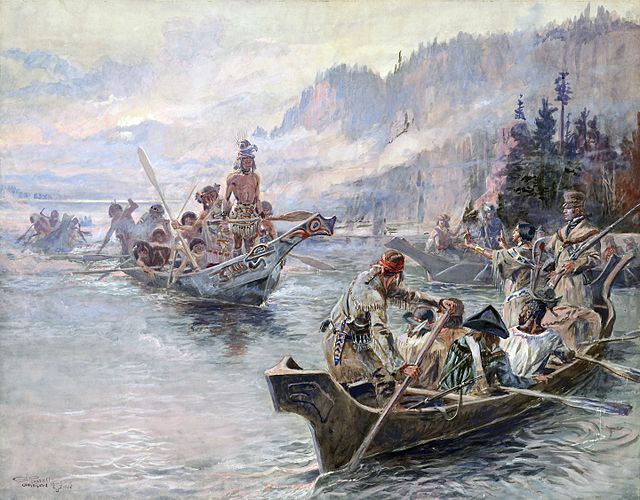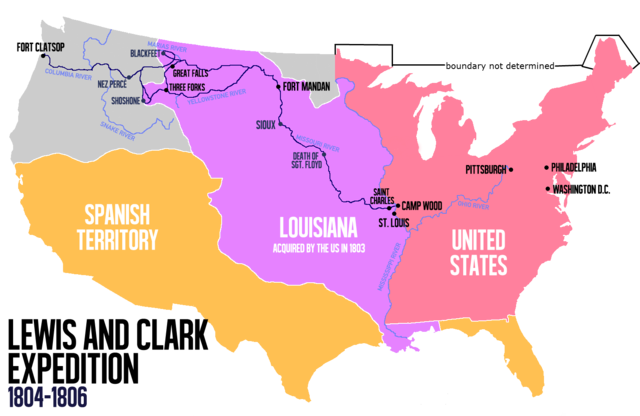We all love venison, but these famed explorers took it to gut-busting extremes – by our modern standards. How extreme, you ask? How does 6,500 calories a day sound?
Not much is known about the specific deer hunting exploits of famed explorers Lewis & Clark’s team, but what we do know is they loved venison as much as anything. That might be due to venison’s great flavor, or it might be because, well, meat’s meat and a man’s gotta eat. And when you’re lugging boats, supplies and blocks of lead around the wilderness, well, you burn a lot of calories.

Lewis & Clark Trail West
Their expedition started on May 14, 1804, when they left Wood River, Illinois (one year after the Louisiana Purchase). Their final stop was an area near what is now Astoria, Oregon. The entire trip took a little more than 28 months. They returned to Wood River on Sept. 23, 1806, completing the nation’s most famous Corps of Discovery Expedition.
The team consisted of Lewis, Clark and 31 other men. It was a grueling trip, but only one man died — Sgt. Floyd who passed early in the expedition from a burst appendix while the crew was traveling through Sioux City, Iowa.
The history of the expedition requires hours of reading, and it’s well worth it, but one nugget that I find most fascinating is the meat consumption — particularly venison — that these early explorers exercised on the trip.
Lewis & Clark Deer Hunts
According to Clark, the men loved whitetail venison (and presumably mule deer as well) as they traversed the 3,700 miles in boats and on foot.
“We eat an emensity of meat,” Clark wrote, adding that a day’s food requirement — just 24 hours — required a successful hunt consisting of four whole deer; or one whole elk and one deer; or one whole buffalo. When game animals were plentiful, each man would eat up to 9 pounds of meat per day (6,500 calories).
Venison was boiled, fried and made into jerky, but a favorite supper was simply to grill it fresh over red-hot oak coals.
Granted, the explorers found protein in fish and fowl along the way, but it’s reasonable to assume the crew shot, butchered, and ate nearly a thousand deer along the way, which would have included whitetails, blacktails and mule deer. They were already familiar with whitetails, but everything else would have been new to them. They reported 172 animal species, including pronghorn antelope, prairie dogs, bison, moose, elk, brown bears, and “jackass” rabbits (because of their long, donkey-like ears). The name was later shortened, thank goodness.

Guns Used by Lewis & Clark
As for guns, they carried an assortment of rifles and even a pneumatic air rifle, which was brought as a means of impressing native people as they pressed westward. The pump-action air gun could shoot 20 shots before needing to be re-loaded with compressed air.
The hunters most likely carried Kentucky long rifles. Calibers in those days were varied, but the most common were .40 to .48 caliber guns that were accurate out to 100 yards on deer-sized game. These were not the lightweight rifles we use today. A Kentucky long rifle could weigh up to 10 pounds and measure anywhere from 54 to 70 inches long. They were flintlock/percussion-lock muzzleloaders.
The men started the expedition in a keelboat (barge) loaded down with 7 tons (14,000 pounds) of dried food, 200 pounds of gunpowder and 400 pounds of lead for making bullets. Nearly all the ammo supplies were used for procuring food, as there were no battles on the trip West. There was one skirmish in Montana on the return trip in which two native men were shot and killed.
States Lewis & Clark Traveled Through
The trip took them through parts of Illinois, Missouri, Kansas, Nebraska, Iowa, South Dakota, North Dakota, Montana, Idaho, Washington, Oregon. They obviously encountered lots of deer, antelope, bison, bears, turkeys, and other critters on the way.
They documented 120 animals and 182 plants — most of which had not been previously documented. Clark drew detailed maps, and the men also documented more than nine Native American languages. When they returned, Congress doubled the pay of each man in the expedition and gave each member 100 acres of land.

